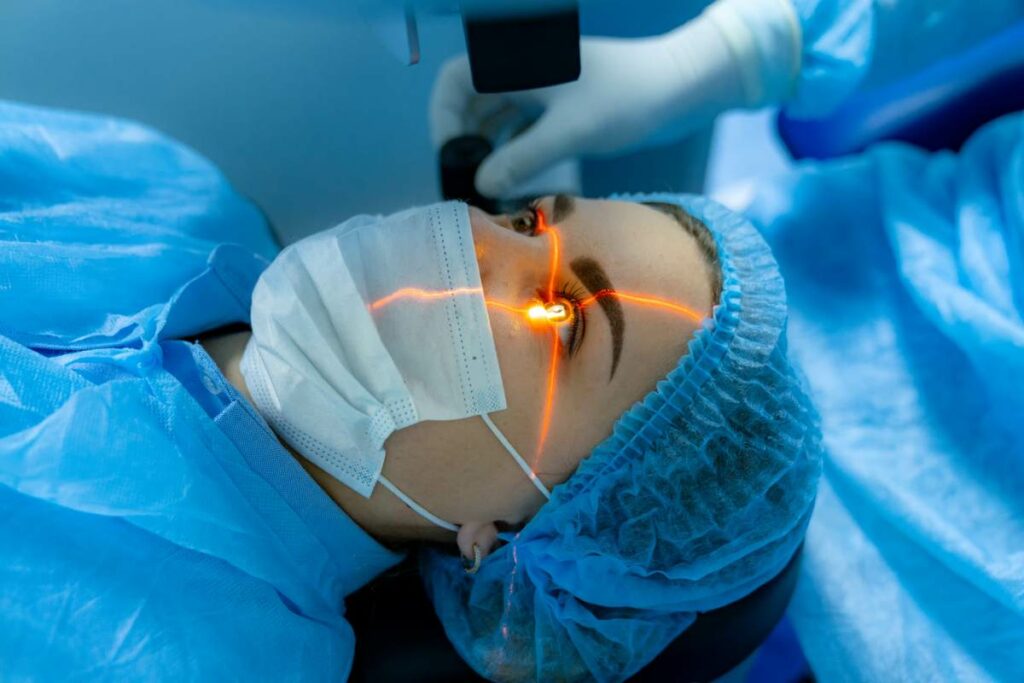Are you tired of relying on glasses or contacts to see clearly? If so, LASIK may be the solution you’ve been searching for. In recent years, advancements in LASIK technology have led to even safer and more precise procedures, such as IntraLase LASIK. In this blog, we will explore what IntraLase LASIK is, how it differs from traditional LASIK, its advantages and disadvantages, and what to consider when deciding if this procedure is right for you.
Contents
What Is IntraLase LASIK?
 IntraLase LASIK is a type of laser eye surgery that uses a femtosecond laser to create a corneal flap instead of using a mechanical microkeratome blade. This technology provides a more precise and controlled way of creating the flap, leading to fewer complications and better visual outcomes. IntraLase LASIK is a popular option for those looking to correct their vision and reduce their dependence on glasses or contacts.
IntraLase LASIK is a type of laser eye surgery that uses a femtosecond laser to create a corneal flap instead of using a mechanical microkeratome blade. This technology provides a more precise and controlled way of creating the flap, leading to fewer complications and better visual outcomes. IntraLase LASIK is a popular option for those looking to correct their vision and reduce their dependence on glasses or contacts.
Procedure Of IntraLase LASIK
The procedure of IntraLase LASIK typically follows these steps:
- The surgeon examines your eye to determine if the patient is a good candidate for LASIK.
- Numbing eye drops are applied to the patient’s eyes to reduce discomfort during the procedure.
- A small flap is created in the cornea using the femtosecond laser, allowing access to the underlying tissue.
- The cornea is reshaped using an excimer laser, which corrects the patient’s vision.
- The corneal flap is repositioned and smoothed out, and the eye is allowed to heal naturally.
The entire procedure usually takes around 15-30 minutes per eye, and most patients can return to their normal activities within a few days after the surgery.
How Is This Unique And Beneficial?
 IntraLase LASIK is unique from other types of LASIK because it uses a femtosecond laser to create the corneal flap, instead of a mechanical microkeratome blade. This technology provides several advantages:
IntraLase LASIK is unique from other types of LASIK because it uses a femtosecond laser to create the corneal flap, instead of a mechanical microkeratome blade. This technology provides several advantages:
- Increases precision: The femtosecond laser in IntraLase creates a more precise and controlled flap, leading to better visual outcomes and reducing the risk of complications.
- Allows for customizable flap creation: This technology allows for customization of the flap creation based on the patient’s corneal thickness and curvature. This customization can improve the accuracy of the procedure and reduce the risk of complications.
- Reduces the risk of flap complications: Using a laser to create the corneal flap reduces the risk of flap complications such as incomplete flaps, buttonholes, and free caps that can occur with mechanical microkeratome blades.
- Provides faster recovery time: IntraLase LASIK typically has a faster recovery time than other types of LASIK. Since the corneal flap created with the femtosecond laser is more precise and uniform, it can heal more quickly and efficiently. Most patients can return to their normal activities within a few days after the procedure.
Overall, IntraLase LASIK provides a safer, more precise, and customizable approach to vision correction surgery, making it a popular option for those looking to reduce their dependence on glasses or contacts.
Disadvantages To Consider
 While IntraLase LASIK offers several advantages over other types of LASIK, some potential disadvantages to consider are:
While IntraLase LASIK offers several advantages over other types of LASIK, some potential disadvantages to consider are:
- Cost: IntraLase LASIK is typically more expensive than traditional LASIK procedures that use a mechanical microkeratome blade. The increased cost is due to the advanced technology used in IntraLase LASIK and the higher level of skill and training required to perform the procedure.
- Longer Procedure Time: IntraLase LASIK typically takes longer to perform than other types of procedures. The femtosecond laser used in this surgery takes more time to create the corneal flap than a mechanical microkeratome blade, adding to the overall procedure time.
- Increased Risk of Light Sensitivity: Some patients may experience increased light sensitivity after surgery. This sensitivity can last for a few days to a few weeks after the procedure and may require the patient to wear sunglasses or avoid bright light during this time.
- Potential for Flap Dislocation: While this surgery reduces the risk of flap complications, there is still a small risk of flap dislocation in the weeks or months following the procedure. This risk is higher in patients who engage in contact sports or activities that may result in trauma to the eye.
- Not Suitable for Everyone: It may not be suitable for patients with certain eye conditions, such as thin or irregularly shaped corneas, severe dry eye, or other underlying eye diseases.
It’s important to discuss these potential disadvantages with your eye surgeon and carefully weigh the risks and benefits before deciding if IntraLase LASIK is the right choice for you.
IntraLase LASIK v/s Traditional LASIK
 The main difference between IntraLase LASIK and traditional LASIK is the method to create the corneal flap during the procedure.
The main difference between IntraLase LASIK and traditional LASIK is the method to create the corneal flap during the procedure.
In traditional LASIK, a mechanical microkeratome blade creates a corneal flap. The blade is a small, oscillating metal instrument that makes a thin, hinged flap in the outer layer of the cornea. The surgeon then lifts it and uses a laser to reshape the underlying corneal tissue to correct the patient’s vision.
In IntraLase LASIK, a femtosecond laser creates the corneal flap. The laser delivers rapid pulses of light energy to create microscopic bubbles within the corneal tissue, which then separate the corneal layers and create the flap. Once the flap is created, the surgeon lifts it and uses a laser to reshape the underlying corneal tissue to correct the patient’s vision.
Some of the key differences between IntraLase LASIK and traditional LASIK include:
- Precision: IntraLase is more precise than traditional because the femtosecond laser used to create the corneal flap allows for a more controlled and uniform thickness of the flap.
- Customization: IntraLase LASIK allows for a more customized flap creation based on the patient’s corneal thickness and curvature. This can improve the accuracy of the procedure and reduce the risk of complications.
- Recovery time: IntraLase surgery typically has a faster recovery time than traditional one, with most patients experiencing improved vision within a few days after the procedure.
- Cost: IntraLase is generally more expensive than traditional due to the advanced technology used in the procedure.
Overall, both traditional LASIK and IntraLase LASIK are effective in correcting vision. IntraLase LASIK is a safer, more precise, and customizable approach to vision correction surgery.
Conclusion
In Conclusion, IntraLase LASIK is a modern approach to vision correction surgery that offers several advantages over traditional LASIK. It uses advanced femtosecond laser technology to create a precise and customizable corneal flap, leading to better surgical outcomes and faster recovery times. While IntraLase LASIK is generally safe and effective, it’s important to consider the potential disadvantages and seek help from a qualified eye surgeon when deciding if this procedure is right for you.
Lasik surgery is a safe 10-minute procedure to help you get rid of glasses. EyeMantra offers the most advanced LASIK options including PRK, Femto LASIK, SMILE surgery, Standard LASIK, ICL, and Contoura vision. If you have any questions on LASIK surgery in Delhi, Lasik surgery cost, and Lasik procedure, call us at 9711116605 or email at [email protected].


